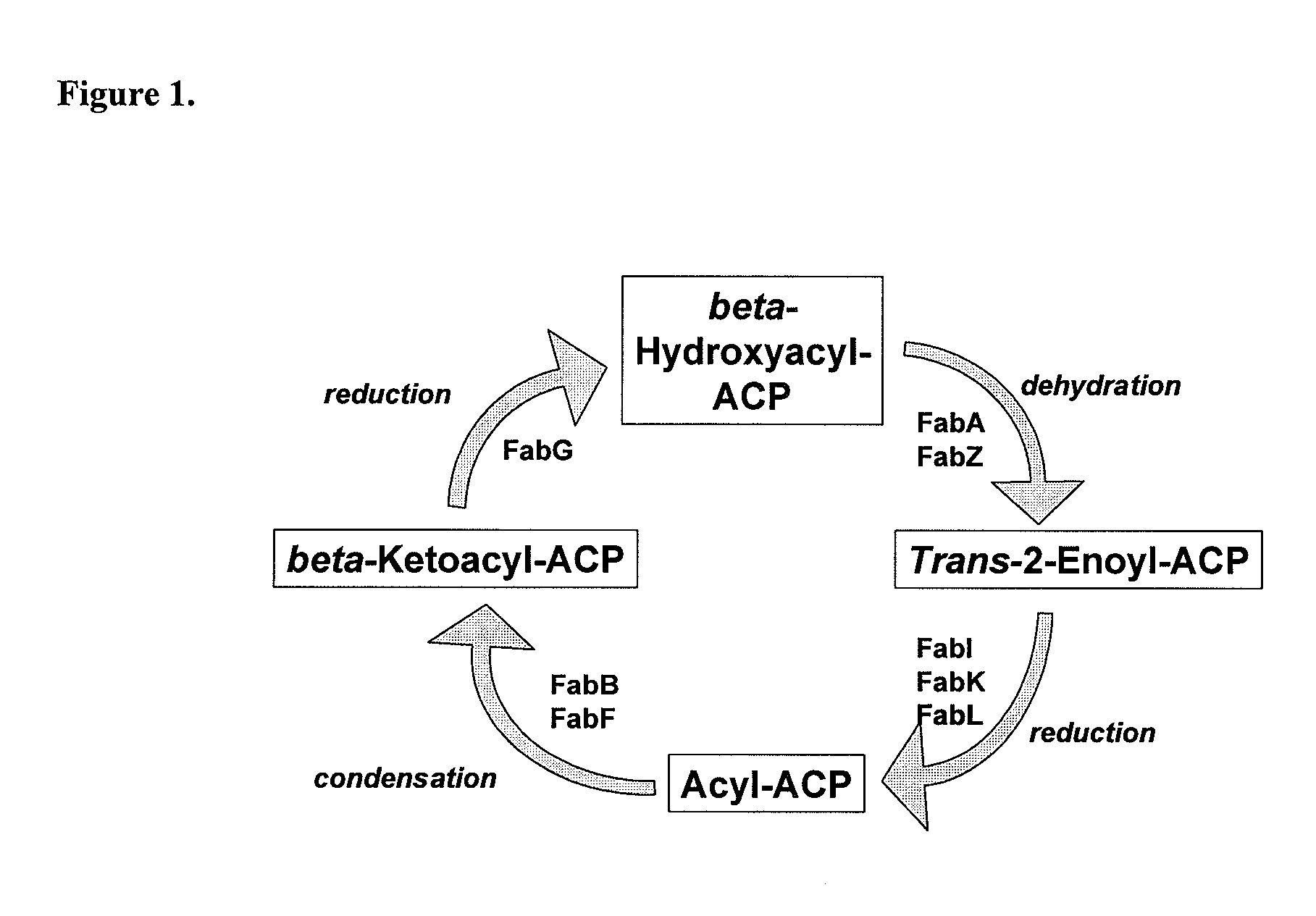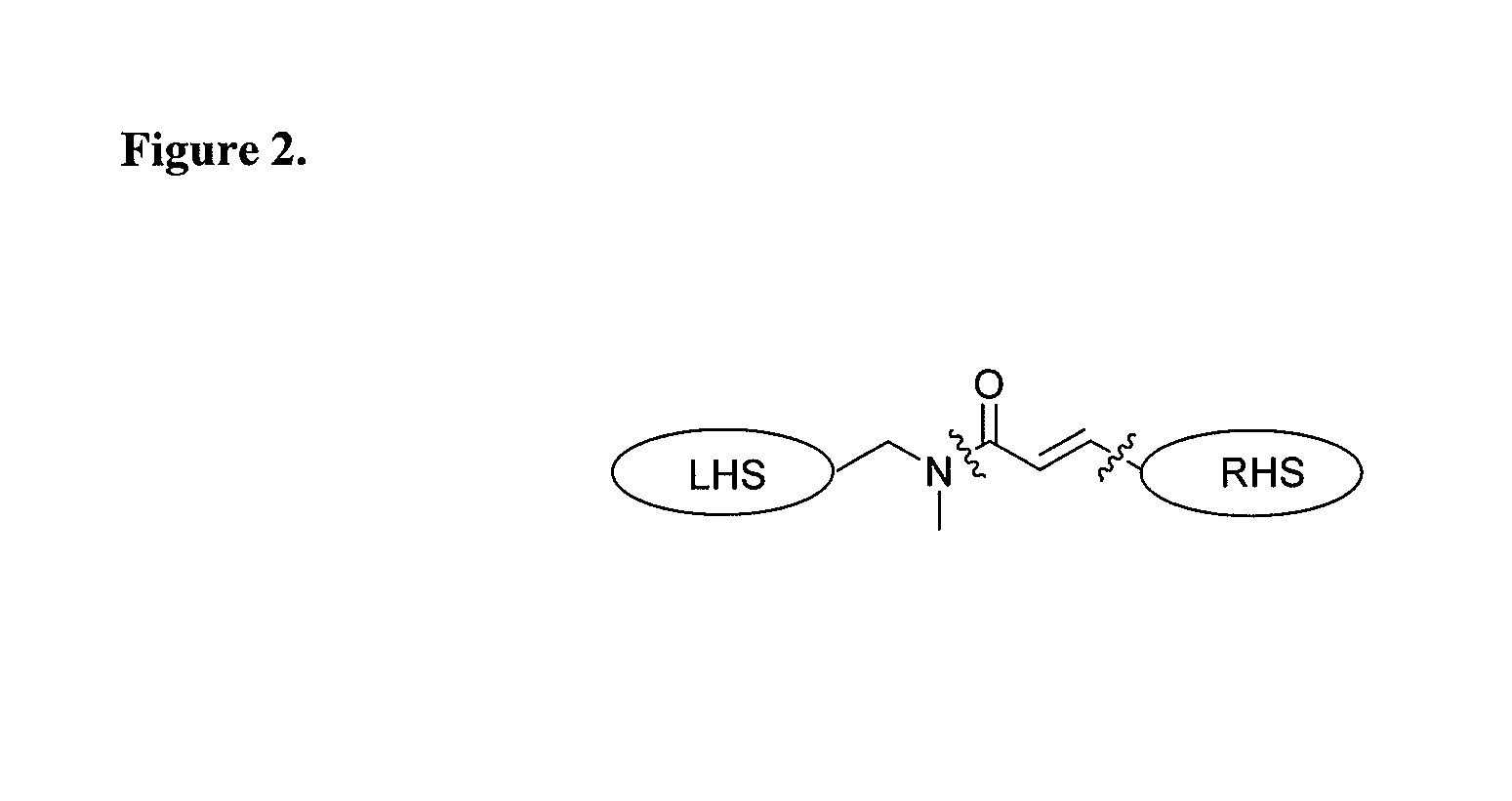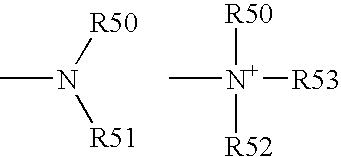Acrylamide derivatives as Fab I inhibitors
a technology of acrylamide derivatives and inhibitors, which is applied in the direction of biocide, antibacterial agents, drug compositions, etc., can solve the problems of unmet medical needs and demand for new agents acting against bacterial targets
- Summary
- Abstract
- Description
- Claims
- Application Information
AI Technical Summary
Benefits of technology
Problems solved by technology
Method used
Image
Examples
example 1
Preparation of (E)-3-(7,7-Dimethyl-8-oxo-6,7,8,9-tetrahydro-5-oxa-1,9-diaza-benzocyclohepten-3-yl)-N-(3-methoxy-2-propoxy-benzyl)-N-methylacrylamide
[0444]
a) 3-(2-Amino-5-bromo-pyridin-3-yloxy)-2,2-dimethylpropionic acid methyl ester
[0445]
[0446]To a suspension of 2-amino-5-bromopyridin-3-ol (1.42 g, 7.51 mmol) in THF (40 mL) was added methyl 2,2-dimethyl-3-hydroxypropionate (1.2 mL, 9.0 mmol) and triphenyl phosphine (2.36 g, 9.00 mmol). The mixture was cooled to 0° C., then treated with diethyl diazodicarboxylate (1.70 g, 9.75 mmol). The mixture was heated in microwave at 120° C. for 20 min. The solvent was concentrated, and the residue was purified by chromatography (silica gel, hexanes / EtOAc, 75:25 to 60:40) to give the title compound (0.88 g, 39%) as a white solid: 1H NMR (300 MHz, CDCl3) δ 7.73 (d, J=2.1 Hz, 1H), 7.02 (d, J=2.1 Hz, 1H), 4.65 (br s, 2H), 3.96 (s, 2H), 3.71 (s, 3H), 1.34 (s, 6H); ESI MS m / e 303 (M+H)+.
b) 3-Bromo-7,7-dimethyl-6,7-dihydro-9H-5-oxa-1,9-diaza-benzocycl...
example 2
Preparation of (E)-3-(7,7-Dimethyl-6,7,8,9-tetrahydro-5-oxa-1,9-diaza-benzocyclohepten-3-yl)-N-methyl-N-(3-methyl-benzofuran-2-ylmethyl)acrylamide
[0451]
[0452]
a) 3-Bromo-7,7-dimethyl-6,7,8,9-tetrahydro-5-oxa-1,9-diaza-benzocycloheptene
[0453]To a solution of 3-bromo-7,7-dimethyl-6,7-dihydro-9H-5-oxa-1,9-diaza-benzocyclohepten-8-one (620 mg, 2.28 mmol) in THF (15 mL) was added BH3 (9.1 mL of a 1 M solution in THF, 9.1 mmol), and the mixture was heated to reflux overnight. After cooling, the solvent was removed in vacuo. The residue was dissolved in MeOH (15 mL) and 2 N NaOH (5 mL), and the mixture was heated to reflux for 4 h. Methanol was then removed in vacuo and the resulting precipitate was collected by filtration to give the title compound (260 mg, 44%) as a white solid: 1H NMR (300 MHz, CDCl3) δ 7.78 (d, J=1.8 Hz, 1H), 7.19-7.18 (m, 1H), 4.60 (br s, 1H), 3.83 (s, 2H), 3.10 (d, J=3.9 Hz, 2H), 1.03 (s, 6H); ESI MS m / e 257 (M+H)+.
[0454]
b) (E)-3-(7,7-Dimethyl-6,7,8,9-tetrahydro-5-oxa...
example 3
Preparation of 3-(7,7-dimethyl-8-oxo-6,7,8,9-tetrahydro-5-oxa-1,9-diaza-benzocyclohepten-3-yl)-N-methyl-N-[1-(R)-(3-methyl-benzofuran-2-yl)-ethyl]acrylamide
[0456]
[0457]
a) (R)—N-methyl-N-[1-(3-methyl-benzofuran-2-yl)-ethyl]acrylamide
[0458]To an ice cold mixture of (R)-methyl-[1-(3-methyl-benzofuran-2-yl)-ethyl]amine (7.5 mL of a 0.46 M solution in DMF, 3.5 mmol) and Et3N (0.6 mL, 4.1 mmol) was added acryloyl chloride (0.3 mL, 3.8 mmol) drop-wise. The mixture was slowly warmed to room temperature and stirred overnight. The mixture was diluted with H2O and extracted with Et2O (3×). The combined organics were washed with H2O and satd NaCl, dried (Na2SO4) and concentrated. Purification by column chromatography (silica gel, 7:3 hexanes / EtOAc) gave the title compound (630 mg, 75%) as a yellow oil: 1H NMR (300 MHz, DMSO-d6) 7.50-7.47 (m, 1H), 7.44-7.41 (m, 1H), 7.30-7.20 (m, 2H), 6.81-6.52 (m, 1H), 6.40-6.25 (m, 2H), 5.74-5.70 (m, 1H), 2.99-2.90 (m, 3H), 2.23 (s, 3H), 1.69-1.58 (m, 3H).
[04...
PUM
 Login to View More
Login to View More Abstract
Description
Claims
Application Information
 Login to View More
Login to View More - R&D
- Intellectual Property
- Life Sciences
- Materials
- Tech Scout
- Unparalleled Data Quality
- Higher Quality Content
- 60% Fewer Hallucinations
Browse by: Latest US Patents, China's latest patents, Technical Efficacy Thesaurus, Application Domain, Technology Topic, Popular Technical Reports.
© 2025 PatSnap. All rights reserved.Legal|Privacy policy|Modern Slavery Act Transparency Statement|Sitemap|About US| Contact US: help@patsnap.com



